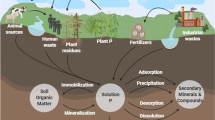Abstract
This article reports studies on the coagulation of kaolin(from Wuxian, Jiangsu, China) on various red tide organisms, and the observation for the first time that the coagulation of kaolin is much greater than that of montmorillonite so that kaolin is a more effective, clay for removing red tide organisms. The authors’ theoretical explanation and analysis by a mathematical-physical model prove that compared to montmorillonite, kaolin has greater attraction for organism cells and therefore greater coagulation capability. This project’s studies on the effects of pH and acid-treatment show that the acid-treatment does not have much influence of the kaolin system; whereas the effect of pH on the kaolin system is the same as that on the montmorillonite system.
Similar content being viewed by others
References
Hauser, E. A. and Beau, D. S., 1946. Colloid chemistry of clay minerals and clay films, Colloid Chemistry VI (J. Alexander Ed.), Rnnhold Publishing Corporation, New York, pp. 191–213.
Hiemenz, P. C., 1977. Principles of Colloid and Surface Chemistry, Marcel Dekker, Inc., New York, p. 420.
Hunter, R. J. and Alexander, A. E., 1963. Surface properties and flow behavior of kaolinite, Part I.J. Colloid Sci. 18: 820–832.
Hunter, R. J. and Alexander, A. E., 1963. Surface properties and flow behavior of kaolinite, Part II.,J. Colloid Sci 18: 833–845.
Parfitt, G. D. and Peacock, J., 1978. Stability of colloidal dispersions in nonaqueous media, Surface and Colloid Science Vol. 10 (Matijeic, E. Ed.), Plenum Press, New York, p. 171.
Shirota, A., 1980. extermination of the red tide organisms, Red Tide-Occurrence Mechanism and Control (Japanese Fishery Society Ed.). Koseisha Koseikaku, pp. 105–123.
Swartzen-Allen, S. L. and Matijevic, E., 1974. Surface and colloid chemistry of clays.Chemical Reviews 74(3): 385–400.
Yu Zhiming, Zou Jingzhong and Ma Xinian, 1994. Application of clays to removal of red tide organisms (I), (II),Chinese J. Oceanol. Limnol. 12(3): 193–200;12(4): 316–324.
Zhang Tianle and Wang Zengliang, 1978. Electron Microscope studies of Chinese clay minerals, Chinese Geology Publishing House, pp. 182. (in Chinese)
Author information
Authors and Affiliations
Additional information
Contribution No. 2244 from the Institute of Oceanology, Chinese Academy of Sciences.
Project supported by Chinese Postdoctoral Fund and Shandong, Natural Science Fund No. 93E0157.
Rights and permissions
About this article
Cite this article
Zhi-ming, Y., Jing-zhong, Z. & Xi-nian, M. Application of clays to removal of red tide organisms III. The coagulation of kaolin on red tide organisms. Chin. J. Ocean. Limnol. 13, 62–70 (1995). https://doi.org/10.1007/BF02845350
Received:
Accepted:
Issue Date:
DOI: https://doi.org/10.1007/BF02845350




